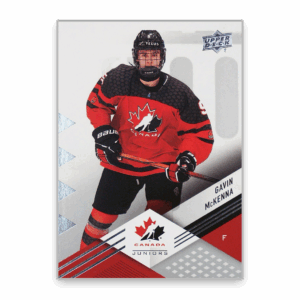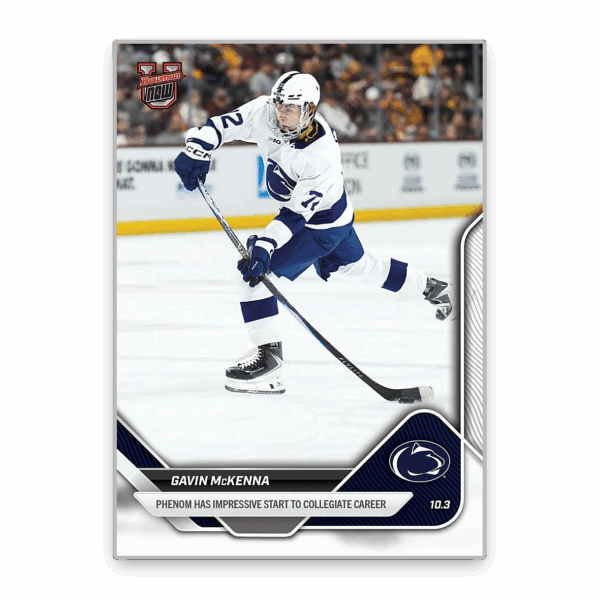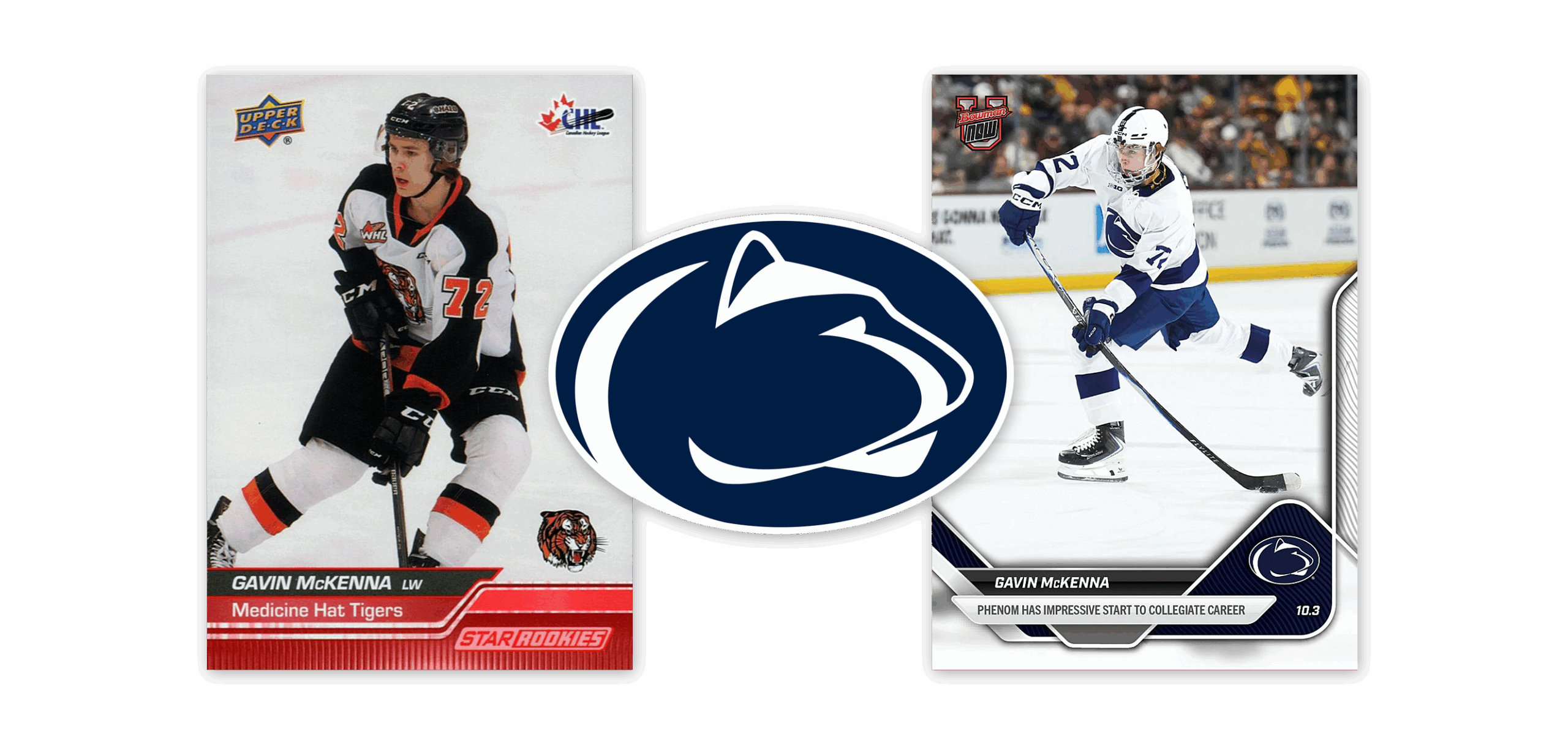Gavin McKenna, the projected No. 1 pick in the 2026 NHL Draft, made headlines in June 2025 with his commitment to Penn State University. The 17-year-old forward reportedly received the biggest NIL (Name, Image, Likeness) offer in college hockey history, described as an “extremely generous six-figure” deal, with reports indicating his earnings could reach as high as $750,000 USD.
“This is the next step in my development to reach my ultimate goal of playing in the NHL” said the Whitehorse, Yukon Territory native on ESPN’s SportsCenter when announcing his commitment to PSU. “It was a super tough decision, obviously there’s a lot of great options out there, but I think me, my family and everyone who is a part of my circle we all decided that the best spot for me next year will be Penn State University.”
This landmark decision represents a major shift in hockey development and hockey trading cards. McKenna spent just over two seasons in the Western Hockey League (WHL) with the Medicine Hat Tigers, where he established himself as a generational talent. His junior career was marked by exceptional production and numerous accolades, including CHL Rookie of the Year and both CHL and WHL Player of the Year honours, as well as being named to Canada’s 2024-25 World Junior team as a 2026 NHL Draft-eligible player.

“McKenna is in a special category that you only come across every few years,” said Dan Marr, NHL Central Scouting vice president and director, about McKenna’s talent on NHL.com. “His offensive instincts and playmaking game are truly exceptional and it’s his composure, compete and maturity that really sell you on his talent.”
Impact on Hockey Development
McKenna’s move to Penn State exemplifies how recent NCAA rule changes are reshaping hockey’s landscape. Previously, CHL players were barred from NCAA competition due to amateurism rules, as the NCAA considered CHL players professionals because undrafted or unsigned players competed alongside teammates who had signed NHL entry-level contracts. The new eligibility rules allow prospects with QMJHL, OHL, and WHL experience to play NCAA hockey beginning in the 2025-26 season.
For CHL teams, retaining their best young players will become significantly more challenging. Rather than completing their full major junior careers in the CHL, some prospects may reconsider their options and transition to the NCAA after high school graduation, sometimes motivated by NIL opportunities. This shift could fundamentally alter the traditional development pipeline of Canadian junior players going directly to professional hockey.
Penn State’s Championship Aspirations
McKenna joins a Penn State program that reached the Frozen Four without him and has added significant talent, including defenseman Jackson Smith, who was drafted 14th overall in the 2025 NHL Draft by the Columbus Blue Jackets. The Nittany Lions are positioned to make another serious run at a National Championship with this unprecedented recruiting class.
The addition of McKenna represents more than just talent acquisition — it’s a statement about Penn State’s ambitions and the changing economics of college hockey. McKenna is considered the highest profile recruit in NCAA hockey history, and his commitment could signal a new era where top prospects view the NCAA as a strong alternative to the traditional junior hockey system.
Trading Card Market Implications
McKenna’s transition from the CHL to NCAA hockey also creates unique dynamics in the trading card market, particularly given the complex licensing landscape. Upper Deck holds the CHL license, meaning his Medicine Hat Tigers cards fall under their umbrella, while Topps/Fanatics has licenses with the NCAA and an exclusive license with Penn State. In addition, Upper Deck holds the Hockey Canada license.
This licensing divide creates interesting opportunities and challenges. While his junior hockey cards from his time in Medicine Hat will remain valuable collectibles documenting his early career, his move to Penn State has opened the door for Topps to feature him in NCAA and Penn State-specific products. And that time has come.

Following McKenna’s Penn State debut on October 3rd, in which he tallied two assists in a 6-3 victory, Topps announced the release of his on-demand 2025-26 Bowman U Now card #1 (with an impressive print run of 14,060 copies). The card was available for sale from October 4th to 7th. Topps is clearly aware of McKenna’s potential impact on the hobby, offering randomly-inserted parallels, rare numbered parallels, memorabilia, and autograph cards for this Bowman U Now release. Here are the full details of this significant card, directly from Topps.
The shift to NCAA hockey complicates the traditional card release schedule, as college hockey players typically have much more limited card opportunities compared to their CHL counterparts. This could potentially create demand and anticipation for more future collegiate hockey releases from Topps.
Additionally, McKenna’s historic NIL deal and high-profile commitment may influence how card companies approach other prospects making similar CHL-to-NCAA transitions. The precedent he’s setting could lead to more strategic card releases tied to major recruiting commitments, with multiple manufacturers potentially competing for the most attractive college hockey talent. It should be noted that Panini America also hold licenses with several NCAA schools.
Looking Forward
As of October 29, 2025, McKenna has tallied three goals and seven assists in eight games with the Nittany Lions, ranking him sixth in the Big Ten conference and 12th overall in the NCAA.
If the current group of CHL-to-NCAA-bound players finds success, we could see more 17, 18, 19 and 20-year-olds making the switch in future years. McKenna’s success at Penn State will be closely examined as a litmus test for whether elite CHL prospects can effectively transition to NCAA hockey while earning NIL money and maintaining their development path toward NHL stardom.
The hockey and collectibles worlds will be watching to see if this move pays off for both McKenna and Penn State, potentially reshaping how future top prospects approach their amateur careers.
NOTE: this story has been updated with new information.

Baron Bedesky
Editor-In-Chief, Researcher
Collector since: 1969
Currently: Vice-President of Hockey Operations for the PHPA (Professional Hockey Players’ Association)
Formerly: VP of Communications at In The Game (former NHL/NHLPA card licensee). Editor and Trends Editor at Trajan Publishing (Charlton Standard Catalogue of Hockey Cards, Canadian Baseball Cards, Canadian Sports Collector magazine, SLAB, Non-Sport Report, and more).






